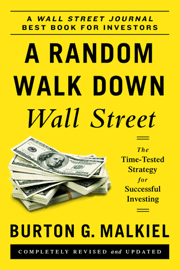 I just finished up A Random Walk Down Wall Street by Burton G. Malkiel. This book became famous in 1973 for suggesting that a bunch of monkeys throwing darts at the Wall Street Journal could beat out most professional managers. And that theme, supported by a lot of statistics spit out by a lot of grad students, endures today. As the Amazon editorial review puts it succintly:
I just finished up A Random Walk Down Wall Street by Burton G. Malkiel. This book became famous in 1973 for suggesting that a bunch of monkeys throwing darts at the Wall Street Journal could beat out most professional managers. And that theme, supported by a lot of statistics spit out by a lot of grad students, endures today. As the Amazon editorial review puts it succintly:
Malkiel advises investors to “buy and hold” a diversified portfolio heavy on index funds that passively mirror the market, which usually out-perform actively managed funds.
It also contains history about the stock market, and a straightforward discussion of common terms like “P/E” and “Beta” and “EMA”. Overall, I found the book very enjoyable and an easy read, and I can see how transaction costs in actively managed funds eat into the final return. Low expenses are key. The final part is what “diversified” means, as in asset allocation. The book does give the following suggestion for people in their mid-20s:
65% Stocks / 20% Bonds / 10% Real Estate / 5% Cash
This book is a great primer on investing overall and also gives some useful pointers on bulding your own portfolio.
 The Best Credit Card Bonus Offers – 2025
The Best Credit Card Bonus Offers – 2025 Big List of Free Stocks from Brokerage Apps
Big List of Free Stocks from Brokerage Apps Best Interest Rates on Cash - 2025
Best Interest Rates on Cash - 2025 Free Credit Scores x 3 + Free Credit Monitoring
Free Credit Scores x 3 + Free Credit Monitoring Best No Fee 0% APR Balance Transfer Offers
Best No Fee 0% APR Balance Transfer Offers Little-Known Cellular Data Plans That Can Save Big Money
Little-Known Cellular Data Plans That Can Save Big Money How To Haggle Your Cable or Direct TV Bill
How To Haggle Your Cable or Direct TV Bill Big List of Free Consumer Data Reports (Credit, Rent, Work)
Big List of Free Consumer Data Reports (Credit, Rent, Work)
A little late, but the book is called “A Random Walk Down WALL Street”, not “WALK Street”.
LOL, I can’t believe no one (including me) caught that until now.
Have you read “A Non-Random Walk Down Wall Street”? –it basically refutes the main premise of that book. Just asking.
I’ve heard of it. The idea does sound interesting, but it sounded like a pretty dry academic text. On top of that, the reviews I’ve read don’t suggest that the casual investor (or even pro) can necessarily profit consistently from such inefficiencies.
But on a certain level, I’ve personally always had a hard time believing the market is 100% random. Just random enough 🙂
I agree–it wasn’t that interesting. I also read “Origin of Wealth”, which is a large book, but explains the “evolutionary” nature of investing strategies and that the prices in the market support a “power log” profile (i.e., price moves twice as large happen 25% as often). I thought it was interesting.
I agree–it wasn’t that interesting. I also read “Origin of Wealth”, which is a large book, but explains the “evolutionary” nature of investing strategies and that the prices in the market support a “power log” profile (i.e., price moves twice as large happen 25% as often). I thought it was interesting.